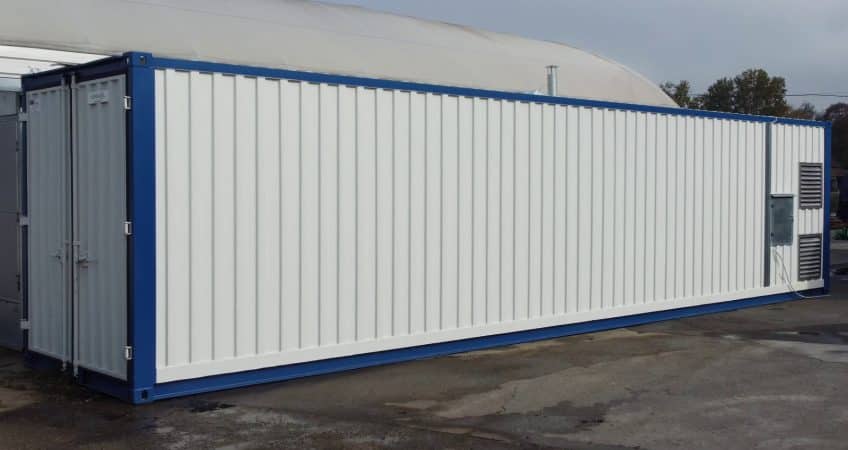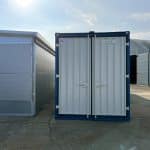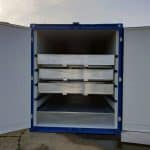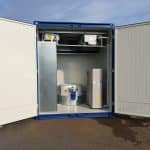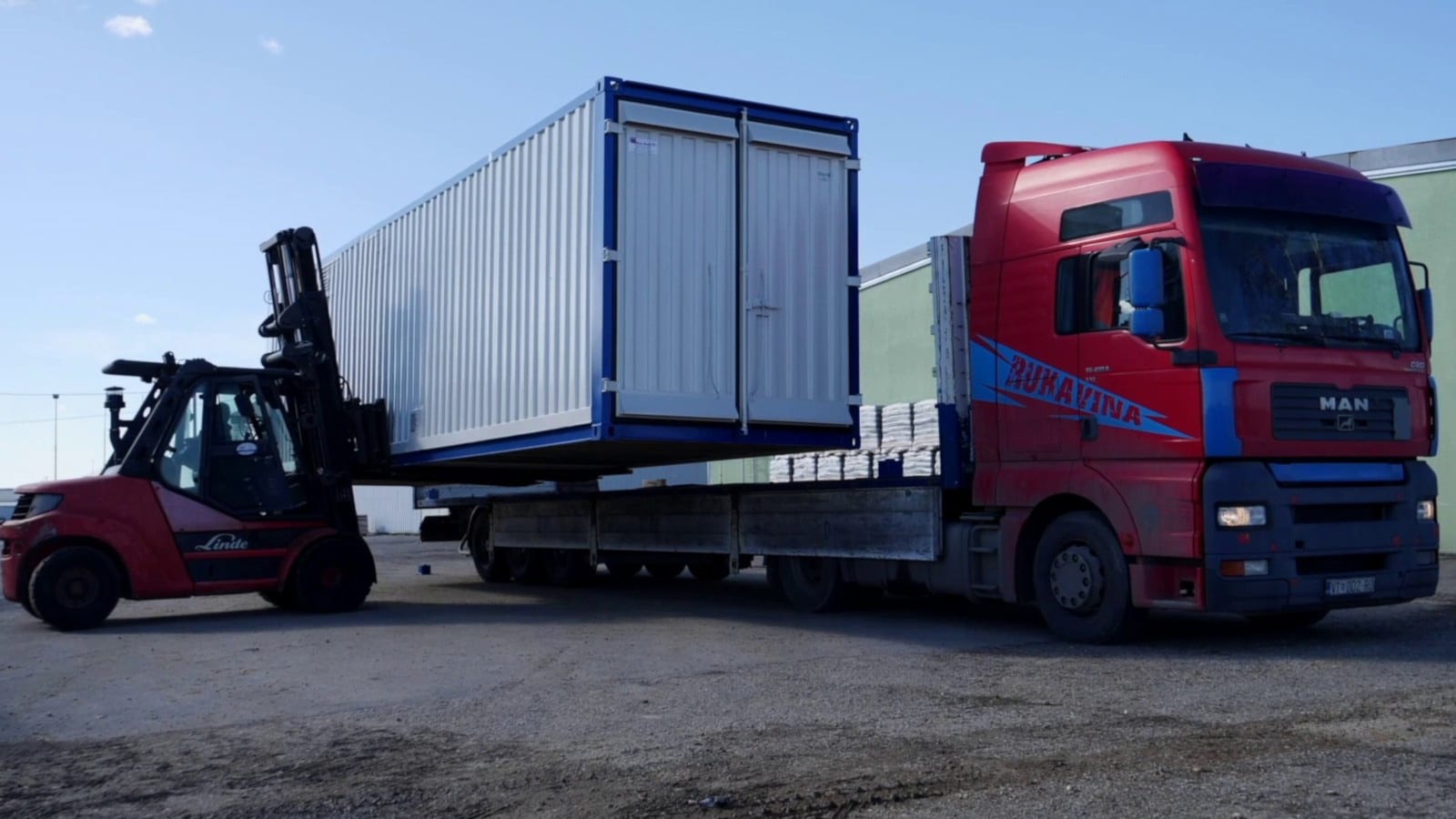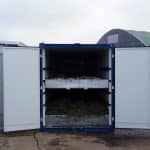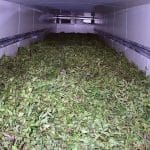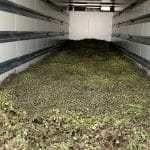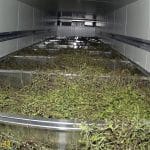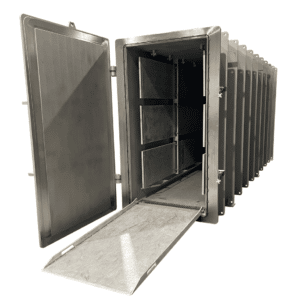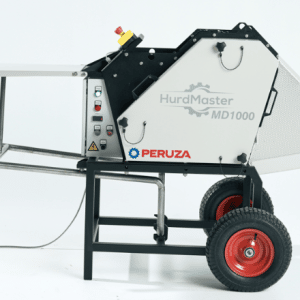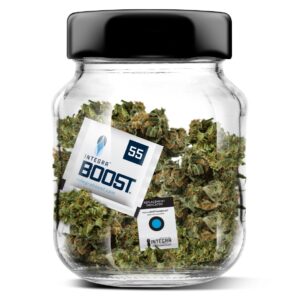Condensation Container dryer – For Industrial Hemp
The container condensation dryer uses compression refrigeration process in order to extract moisture by cooling a stream of air. Primarily, our container condensation dryer is intended to dry medicinal and aromatic herbs like industrial hemp (Cannabis sativa L.), mint (Mentha spicata L.), lemon balm (Melissa officinalis L.), lavender (Lavandula angustifolia Mill.), sage (Salvia officinalis L.), etc. for use in pharmaceutical and food industry. Drying quality for these herbs and alike proves to be significantly better compared to the one achieved by drying in classic convection dryers using warm air (with temperatures under 45°C). Drying this way organoleptic properties (color, aroma, flavour) of dried material are preserved, as are temperature susceptible and volatile biochemical compounds like terpens for example. Part of volatile compounds are extracted in condensate.
Container condensation dryer – details
Whole dryer is built in purpose-made container with dimensions of 40′ HC ship container which makes this dryer portable and practically eliminates the need for special assembly operation at the installation site. Container isolation is achieved by using standard plasticized or purposely-built thermal isolation panels.
Customer needs to assure an appropriate three phase electric power connection at the site of installation. There are two double winged doors – one on the front and one on the back of the container. Material is loaded in through the front doors. From the back, one has access to devices of the dryer. On the side, closer to the rear end, one can find a digital controller unit by which control over the drying process parameters is achieved. Also, next to it – an electrical cabinet with all necessary electrical elements.
Material placement inside the dryer
There are two options – two ways to place material in the dryer: on the floor or in shelves. With floor dryer, material to be dried is placed evenly on the perforated floor so that it makes a layer of uniform height. Layer height depends on the material to be dried. Industrial hemp for example – in the form of top cut (upper part of stem and leaves) can be loaded to a height of 1,7 meters (5.6′), and some other materials that, when evenly loaded, make a tighter, denser pile should be loaded to lower heights of about 40 – 50 centimeters (15”-20”).
Instead of spreading material onto the floor in one layer, another option is to spread material across several layers and into purposely-made shelves with wheels. Shelves can be taken out and put back in using a forklift. Also, another type of shelves can be made so that they are inserted onto a trolley with wheels with which one can manually manipulate. In any case, it is important to evenly spread and shake the material so that it does not compact. That way, a uniform drying of the material throughout the dryer is achieved. With floor dryers – there is an option to supply a moveable floor to ease material loading and unloading from the dryer. Effective drying area equals to 20 square meters (216 square feet). Batch volume capacity depends of the material that is to be dried and associated layer thickness.
Working principle of the condensation dryer
The container condensation dryer uses devices that implement vapor compression refrigeration process so that it extracts moisture from the material by cooling an air stream. There are two condensation and air conditioning devices of different rated power. Both of them are composed of two units – “external” and “internal” unit. It is common to call an external unit – a condenser, and an internal unit – an evaporator regarding phase change of the refrigerant fluid inside.
The refrigerant condenses in the condenser and evaporates in the evaporator. That should not be mistaken with air condensate which actually is collected in evaporator – that is – the internal unit of the condensation and air conditioning device. In the back of the condensation dryer, a ventilator is found that induces air flow. Air in induced circulation passes through wet material, collects moisture, and then returns to the back part of the dryer. That air passes through the evaporator of more powerful condensation and air conditioning device and is in turn cooled down. Low temperature air has less “ability to carry water”, so part of water vapor condenses and is collected in the device – and via tubes directed to the outside of the dryer. Part of internal air passes through the condenser and heats up again.
Performance and method of extracting moisture
Theoretically, change in air temperature due to the working of this device should be equal to zero. But, because of unavoidable losses – part of mechanical work is converted to thermal energy – there is a need of another device that regulates the temperature inside the dryer. Another condensation and air conditioning device is therefore needed. It has an evaporator placed in the chamber where the drying material and first device are and a condenser placed inside a closed sheet metal box that has two openings to the outside of the container.
Air from the dryer passes through the evaporator unit which cools it, while condenser unit cools the refrigerant fluid using outside air. No mixing of inside and outside air occurs. Throughout the dryer, humidity and temperature sensors can be placed in order to get a measured temperature and humidity field. That data can then be tracked graphically during some time period on remote desktop. That way, one can experiment and find optimal parameters for it’s process and ensure final product quality.
Condensation dryer process specifics
Condensation dryer principle of working enables drying at lower temperatures than in classic convection dryers with warm air. This way, product quality is ensured and organoleptic properties preserved along with biochemical compounds that are of primary interest. Because there is no mixing of outside air with the air inside the chamber, there is no possibility of contamination during work. There are considerable energy savings compared to convection dryers. Only electric power source is needed, so one can utilize it’s own power source – for example – photovoltaic panels.
Processes at lower temperatures usually bring the water contained inside the plant more slowly to its surface, where it can only evaporate into the air. The retention and movement of moisture inside the material depends on its structure. Therefore, processes at higher temperatures take less time.
| Material | Capacity, t per charge | Drying time, h |
| Hemp (top cut) | 1,5 – 2 | 36 – 60 |
| Hemp (flower) | 1 – 1,5 | 36 – 48 |
| Power, kW | 9,2 kW |
| External dimensions, mm | 12200 mm × 2450 mm × 2900 mm |
| Noise level, Db | 50-60 |
